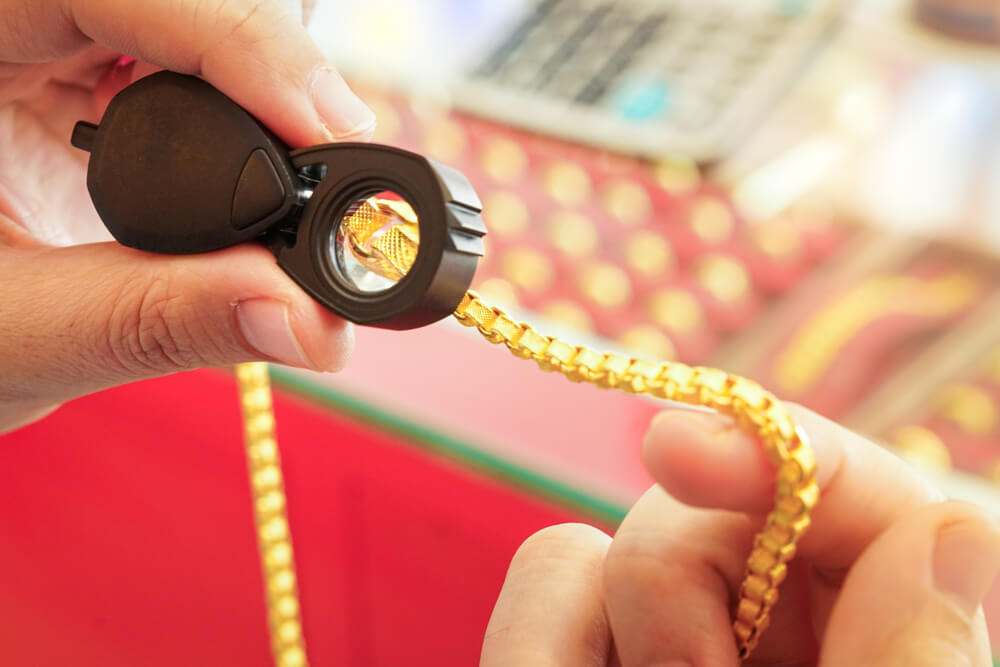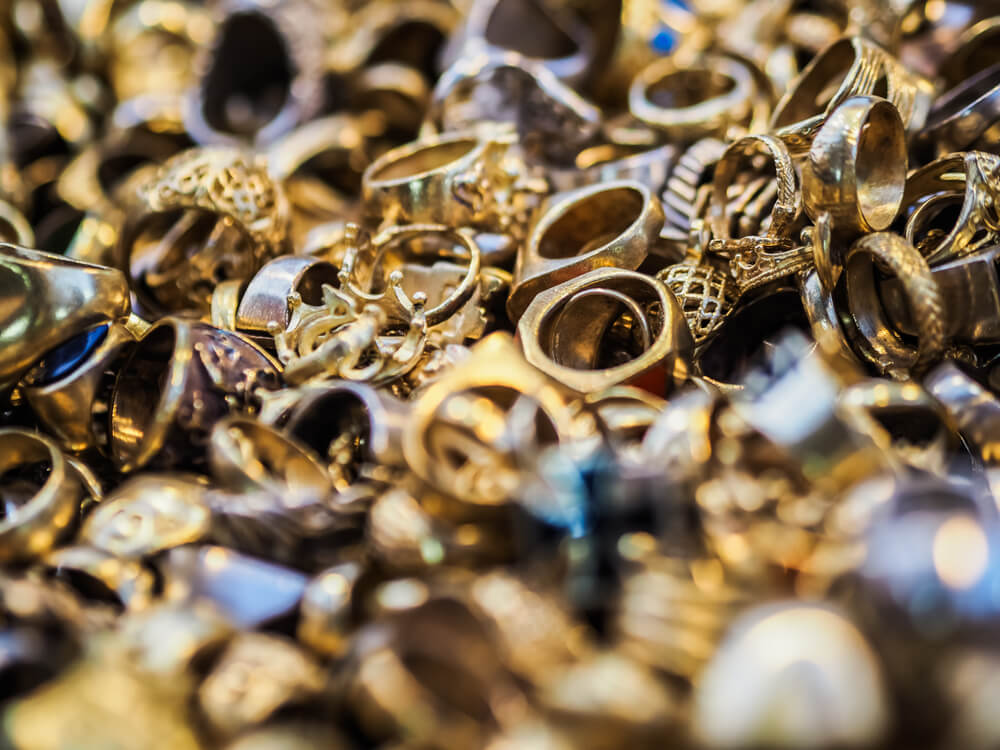
How to Tell If Gold is Real? Spotting Real vs. Fake Gold
If there ever were an award for the most counterfeited product or commodity in the world, gold would be one of the frontrunners to win the prize. Although the imitation gold market exists as a separate, legitimate industry, nefarious gold sellers trying to pass fake gold jewelry as the real deal is the problem.
Buyers, who don’t know better, go by the gold merchant’s word or don’t do much to inspect the precious metal or find out if the gold jewelry sold as authentic gold jewelry is indeed genuine gold.

Luckily, this problem is not industry-wide. The gold market is professional and honest. You need not put up with such duplicity or ingenuous acts from trusted or established jewelers. Things usually become dicey or risky when buying gold jewelry online from an obscure, unverified seller or source.
Therefore, we want to make it easier for you to differentiate real gold from fake gold and spare you some gold shopping nightmares through this article. We’ll elaborate on the following:
- Genuine gold and phony gold
- Gold purity testing methods
- Tell-tale fake gold signs
- The significance of gold jewelry hallmark stamps, and more
If you don’t want to inadvertently buy fake gold and lose money or not have a lousy gold shopping experience, this article is for you. Keep reading.
Table of Contents
Gold: What’s Real, And What’s Fake?
Determining the authenticity of gold is not as straightforward as calling out a gold item as fake or real. Pure gold is absolute gold. Not-completely-pure or impure gold is also real gold. Sounds confusing? Read on.
Even if a gold item is 75% gold (18 karats) and the remaining comprising other metals, it would be considered genuine gold jewelry. A gold item is deemed gold in The States if at least 41.7% of its composition is pure gold. In European countries like Germany, a gold piece qualifies as gold if 33.33% (8 karats) of its makeup is absolute gold. In America, eight karats usually do not qualify as gold.
Does that mean a gold item less than 10 or 8 karats is not gold? Commercially, it is not. Technically, it’s a different picture because the minor gold content those pieces comprise is real gold or worth money. They cannot be sold as “real gold jewelry”, but they are not “not gold entirely”. That said, any gold piece that doesn’t meet the above minimum karat requirements will be considered fake gold.
Read more: Gold Purity Measurements
Gold-Plated Jewelry
Gold-plated jewelry is not the same as gold pieces blended with other metals. Unlike jewelry made of a gold alloy, gold-plated pieces have a thin sheet of gold covering the base or primary metal in the article: copper, brass, silver, etc.
The gold doesn’t have a homogenous relationship with the other metal or the amount of gold used is nowhere close to the minimum quantity of yellow gold an item must have to qualify as gold.
Testing Gold Authenticity

To test any piece of gold, you need not hire a laboratory. You may carry out gold testing right at your home. Also, you won’t require specialized tools. Items already in your kitchen or toolbox would suffice. The following are some standard methods to test gold for its authenticity:
Density Test
Also called the float test, the density test puts the theory “gold is denser than water” to the test.
To perform the assessment, dunk your gold item in water (preferably cold or lukewarm water). Real gold is dense, as stated above. When dipped in water, it must sink to the bottom. If the gold item floats instead, the gold is not genuine.
Imitation gold pieces, such as gold-filled and plated gold items, are usually light and float when thrown in water. Also, if the gold loses color, tarnishes, or rusts, it’s not actual gold since real gold is anti-corrosive and almost indestructible on the aesthetics front.
Vinegar Test
Place your gold article on a flat surface and put some vinegar on it. Do not go overboard or dunk your gold into a vinegar-filled container, as you’d risk damaging the piece’s precious stones with the vinegar exposure.
After the vinegar application, let the gold piece remain untouched for at least 15 minutes. If you notice the gold item changing color, it’s not authentic gold. Pure yellow gold will not change color when subject to vinegar.
As mentioned above, you need to be careful about the quantity of vinegar and how you use it for the test. If you’re unsure about pulling off the test without inflicting any damage to the subject, you may skip the test and try the other techniques.
Magnet Test
The magnet test is ideal for testing gold at home or in a pawn shop. Since gold is not magnetic, gold jewelry shouldn’t attract magnets or respond to their presence in its vicinity.
To perform the test, just hold a magnet near the gold and check for any movements in the yellow metal. If the gold moves or reacts to the magnet’s presence, it is not pure gold. The other metal in the mix could be iron or nickel since they are usually the only ferrous metals to alloy with gold. That essentially means pure gold items could also attract magnets.
And if the gold article doesn’t react to the magnet, it’s again no guarantee that the piece is pure gold. That’s because metals that commonly form alloys with gold are also non-magnetic—namely copper and silver. Then, there’s brass, which is used in gold plating. Brass also doesn’t attract magnets. That essentially means even gold-plated brass would not respond to a magnetic draw.
Long story short, the magnet testing is not conclusive. But it’s fun and also serves as a starting point.
Note: Make sure the magnets you use for the test are strong enough, not some arbitrary piece obtained from your kitchen or toolbox. Get a neodymium magnet from your local home improvement store for increased accuracy.
Ceramic Test
You can also test gold authenticity by rubbing it against a piece of unglazed ceramic tile. Stroking your gold article against the unglazed ceramic plate would cause a tiny portion of the gold to come off as fragments.
Check the color of those remains. If the item leaves behind a black streak on the ceramic plate, you’re dealing with counterfeit gold. But if you see a gold spot, you’ve got authentic gold on your hands.
If leaving behind some gold bits on the stone makes you skip a beat or worries you about the plausible dent in the gold’s value or appearance, do not fret. The ceramic scratch test is much safer than tests involving corrosive acids.
Nitric Acid Test
Nitric acid is commonly used to test the authenticity of gold. The test is so efficient there are gold testing kits that contain multiple bottles of nitric acid for different karats or types of gold (white gold, rose gold, etc.). The equipment could also come with a touchstone—a flat rock to scratch the gold against.
Once you’ve got the nitric acid and the gold ready for the test, follow these steps:
- Scratch the gold with a sharp tool in a discreet spot—the inner band or below the clasp. Ensure the scratch is deep enough to unveil the metal underneath or a new layer of gold altogether.
- Add a drop or two of the acid to the induced scrape. If the gold is plated or filled and the post-scratch revealed metal was copper or silver, the piece would turn green or take up a milky hue.
If the gold passed the above test or didn’t change color and you’re sure the piece is real gold, use the various testing solutions to ascertain or confirm the karat number.
- Rub the gold against the touchstone to leave a gold streak on the rock.
- Pour a drop of 12K gold testing solution on the streak. If the gold is 10K, the line will completely disappear after a few seconds. If it doesn’t, it’s 12 karats or more.
Test the streak with increasing acid strengths or in ascending karat numbers. If the 22K nitric acid solution melts away the gold trace, but the 18K solution doesn’t, it’s safe to assume the gold item is 18K. Kindly note, the nitric acid gold test provides a ballpark measurement of the piece’s actual gold content and not necessarily exact numbers.
Important: Make sure you’re wearing gloves and are in a well-ventilated space while performing the nitric acid test. If the test seems a bit far-fetched or out of your comfort zone, or you fear damaging the gold, get the test done by a jeweler or an expert gold tester.
Signs Your Gold Article is Fake

Before ever-so-slightly imperiling your gold article with the tests mentioned above, look for the following fake gold or indications instead:
Lacking Craftsmanship
A genuine piece of gold would have intricate works done on it. Stones, if any, would have been embedded with meticulousness. With fake jewelry, however, the jeweler wouldn’t care much or not spend hours getting the piece’s looks right. For example, the finishing won’t be to the T, and the embedding work would also not be exemplary. While not always a tell-tale sign, a sub-par design could indicate the piece is not real gold.
Too Good a Price
With basic knowledge about gold’s monetary value, one can ascertain whether a gold piece is priced right. Though it’s not uncommon to see gold articles selling for discounted prices, a massive price cut or a gold item that’s originally worth $100,000 being offered for $10,000 is a big red flag. Long story short, if the deal is too lovely to be true, you’re probably looking at fake gold or an extremely diluted piece.
Get the Piece Professionally Appraised
If the above methods don’t help much, get a professional jeweler to look at the piece. If they like what they see, the gold is real. And if they categorically state there’s no gold on the table, that’s pretty much all the confirmation you need. Since the gold jeweler is an “expert” and someone you trust, you can take their words at face value.
In addition to the above, the following are imitation gold signs you’ll see only after a period of use. Most people who are pretty sure about their gold’s purity and didn’t feel the need to carry out any testing would experience or witness the following if their gold possession, unfortunately, turns out to be fake.
Increased Wear and Tear
Besides the relatively botched look, replica gold jewelry could also have wear and tear marks. Gold-plated jewelry’s thin gold layer rubs away over a period, particularly around its edges. The periphery comes in contact with clothing and/or skin more than the other sections of the gold. When the thin layer wears out, the inner not-very-precious metal reveals itself.
Your Skin Will Let You Know
Your skin reacting adversely to the gold article could signify that the gold you’re wearing is counterfeit.
The thin layer of gold in gold-plated jewelry wears away quickly, exposing the core metal (usually brass or copper) beneath. When you sweat, the brass or copper reacts with the acids in your fluids to form greenish salts, which later get absorbed into your skin. Silver reacts with sweat and leaves behind black marks. Your skin turning green or black is not necessarily harmful, but it could cause a rash or itchy skin.
Kindly note, gold jewelry leaving behind green or black marks on your skin doesn’t necessarily mean the gold is not genuine. Rose gold or white gold, technically real gold, could also leave behind such spots on your skin or clothing since there’s copper and silver in them, respectively.
The tinted marks may not be evident with 22K or even 18K gold. But 14K pink or white gold could leave behind those traces since there’s just 58.3% pure gold in them.
The Skin Test
If you don’t want to leave things too far or dread the thought of green and black hues on your skin, perform this simple test instead.
Apply some foundation to your skin. Once it dries, run the gold over it. You need not rub or push the gold hard against your product-ladened skin. Just make sure there’s meaningful contact between the cosmetic item and your gold piece.
If the gold is real, there won’t be any reactions. But if you see a black streak or greenish hue, the piece is not real gold.
Are Hallmarks Reliable Signs of Gold Purity?
Most retail gold pieces have a hallmark stamped on their underbelly or not-very-visible sides, such as inner bands or jewelry clasps. However, gold bullion coins have their signs pressed right on their face because they are not meant to be worn, and the clear markings help with their trade.
The hallmark could be as per the karat system or number rating system. In Europe, it’s usually the latter. While both are equally good indications of gold content in a given piece, the number system is much easier to decipher, particularly for those not familiar with the gold purity assessment concept.
The number rating methodology uses the 1 to 999 number range—with 1 denoting 0.1% gold and 999 signifying 99.99% real gold. An IRA-approved gold coin would usually be 99.99% pure. On the other hand, real gold jewelry would have a lower score since other metals are added to the piece to ensure its rigidity.
The hallmarks may not be visible due to wear, and some of those inscriptions could be a tad too small to be discernible for the naked human eye. In some instances, there would be no markings—either due to continual wear or because the maker chose not to inscribe the article. Therefore, do not assume the gold is fake because it has no markings.
At the same time, the hallmark sign is no guarantee the piece is real gold since the engraving can be easily duped or replicated. In other words, counterfeit gold pieces could bear the characters too to look authentic.
Long story short, if you’re buying gold from a reputed jeweler, you can pretty much take the hallmark at face value. If, however, you purchased the gold from a not-so-credible or unverified source, you must look beyond the sign to determine the gold’s authenticity.
Fake Gold Jewellery Have Markings Too
Gold-covered or -infused pieces have their markings too. The letter-based markings indicate whether the gold is plated, electroplated, or filled.
- GP means “gold-plated”.
- GF stands for “gold-filled”.
- GEP denotes “gold electroplate”.
The markings could differ based on the imitation gold’s country of origin or seller.
Read more: How Did Gold Become Valuable
Conclusion
The above testing methodologies are different ways to ascertain the authenticity of gold. Some could be more accurate with their results, and quite a few are likely to be nowhere close to conclusive—for instance, the magnet test. Also, none of the tests are foolproof or entirely reliable. You’ll invariably have to perform more than one tests to come closer to the truth.
If, however, you’re not a fan of or not keen to test gold at home, get your piece appraised by a local jeweler. Since jewelers are professionals, they are likely to possess advanced tools or machines for the testing and will likely come up with a lot more accurate results than you could ever muster.
FAQs
Who is a “reputed jeweler”?
A reputed gold jeweler is someone who has been in the industry for years, with favorable customer feedback to their credit. If there are associations that a jeweler must be a member of or certifications they must hold to prove their trustworthiness, look for those credentials in your gold seller. For instance, being recognized by a national body for the gold industry is a must-have qualification.


